In order to get a reference to your UINavigationController in your case, you have to do the following and specify the correct index to your tabBarController first:
UINavigationController *nav = [self.tabBarController.viewControllers objectAtIndex:<THE_INDEX_NUMBER_FOR_YOUR_NAVIGATION_CONTROLLER];
Once you have done so, then you retrieve a reference to your FoodViewController by specifying again the index number for it on your UINavigationController (i.e. if it's on top, then 0):
FoodViewController *destViewController = (FoodViewController*) [self.nav.viewControllers objectAtIndex:0];
Update:
Now that I got a better idea what you would like to achieve:
You are using UITabbarController in which your others controllers are embedded.
Scenario / Example Case:
Let say we had 2 view controllers, controller A and controller B, respectively, both are embedded in a UITabbarController.
What we want:
We are trying to change the text of a UILabel in controller B from controller A.
First, declare a property in controller B in .h:
@property(strong, nonatomic) UILabel *aLabelInControllerB;
Second, declare a a property (or ivar) in your controller A:
@property(strong, nonatomic) ControllerB *controllerB;
Since you are using UITabbarController you don't need to use segue, you could simply
get a hold of UITabbarController via self.tabBarController;
Question: "how would I know then when my tab bar controller is tapped and then change the text of the label in controller B?"
We do this:
Set controller A as the delegate of UITabbarController by:
In controller A .h, add:
@interface <Your_Controller> : UIViewController <UITabBarControllerDelegate>
In viewDidLoad of controller A:
self.tabBarController.delegate = self;
And in controller A .m, implement this method:
- (void)tabBarController:(UITabBarController *)tabBarController didSelectViewController:(UIViewController *)viewController
{
self.controllerB = (ControllerB *) [tabBarController.viewControllers objectAtIndex:1];
//In our example here, we only have 2 view controllers (A and B)
//So, index 1 is where controller B resides.
self.controllerB.aLabelInControllerB.text = @"Hello!";
//This will change the text of the label in controller B
}
And as controller B appears, you will see that the text of the label will be changed to "Hello!"
Setting a NSString in controller B follows the same procedure.
Ex: self.controllerB.stringInControllerB = @"Hi from controller B!";
Hope that helps.
Update 2:
Segue'ing from table view cell to a tab bar controller? Oki.. Here is the solution. I am only using one cell in my example, so should it become desired that you would like to have more cells in the future, I would leave that up to you to adjust.
Let's take a look at the storyboard layout:

In storyboard, control drag from your cell to the tab bar controller.
Add a UINavigationController like in the picture.
In your UITableViewController .m:
Add 2 properties:
@property (strong, nonatomic) UITabBarController *myTabbarController;
@property (strong, nonatomic) YourFirstViewController *myFirstViewController;
Just a friendly reminder:
Remember to add:
self.tableView.delegate = self;
self.tableView.dataSource = self;
Add the following in your table view controller:
- (void)prepareForSegue:(UIStoryboardSegue *)segue sender:(id)sender
{
self.myTabbarController = (UITabBarController*) [segue destinationViewController];
self.myFirstViewController = [self.myTabbarController.viewControllers objectAtIndex:0];
self.myFirstViewController.stringFromTableViewController = @"Hi from TableViewController!";
}
And in myFirstViewController, add 2 properties in .h:
@property (strong, nonatomic) NSString *stringFromTableViewController;
@property (strong, nonatomic) YourSecondViewController *secondViewController;
Like from the second edit above, have your first view controller to be still the delegate of UITabBarControllerDelegate and implement this method:
- (void)tabBarController:(UITabBarController *)tabBarController didSelectViewController:(UIViewController *)viewController
{
self.secondViewController = (YourSecondViewController*) viewController;
self.secondViewController.aLabel.text = self.stringFromTableViewController;
}
Just like before, nothing needs to be changed in SecondViewController.
I ran this myself; should be good to go for your setup.
Enjoy.

